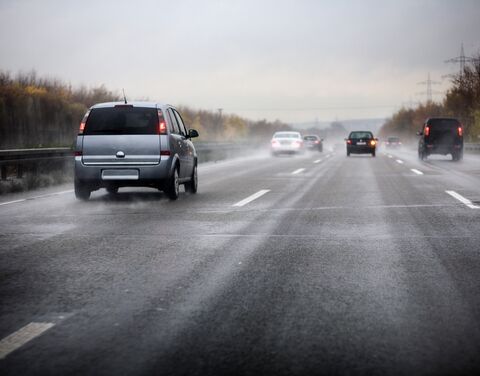
Driving in the rain brings additional risks like poor visibility, longer braking distances, and of course aquaplaning. So what exactly is aquaplaning, why are drivers so scared of it, and – most importantly – what can you do to prevent it? Read our blog to find out.
Aquaplaning is an important topic for anyone learning to drive. It happens when a vehicle's tires lose grip on a wet surface, sending it skidding out of control. You can prevent it by adopting a few good habits. Excessive speed is just one possible cause – there are some other key factors to take into account.
On a wet road, tires need to be able to clear water from the surface to maintain grip. If there's too much water and/or you're driving too fast, they can't do this quickly enough, so water gets wedged between the road surface and the tire, causing the tire to float on a film of water.
The worst-case scenario is total aquaplaning, when the vehicle has no contact whatsoever with the road surface and is completely out of control. You can't steer, you can't brake, and you can find yourself in a very dangerous situation in an instant. Sometimes, for example in a curve, only the tires on one side lose grip, so you still have some control.
Take note of traffic warning sign number 114 "slippery road when wet or dirty." It warns you of stretches of road where the risk of aquaplaning is especially high.
The worst-case scenario is total aquaplaning, when the vehicle has no contact whatsoever with the road surface and is completely out of control. You can't steer, you can't brake, and you can find yourself in a very dangerous situation in an instant. Sometimes, for example in a curve, only the tires on one side lose grip, so you still have some control.
You're driving along on the highway, and it starts to rain. All of a sudden, you notice an unusually loud noise inside the wheel arches. A moment later, you can feel that your car has suddenly lost grip. You don't have time to think. You need to take the right action instinctively.
1. Stay calm: Don't make any abrupt movements. Don't brake, steer or accelerate.
2. Stay on course: Keep a firm grip on the steering wheel and keep it straight, otherwise you could have problems once the tires regain their grip.
3. Reduce your speed: Slowly and carefully take your foot off the gas pedal and press the clutch (or engage "N" if you have an automatic gearbox).
Several things have to happen at the same time to cause tires to float on a film of water. Here are the main risks:
Prevention is key. Lots of accidents caused by aquaplaning can be avoided. Here are our top tips:
1. Pay attention to the road ahead and avoid ruts and large puddles wherever possible.
2. Adjust your speed and turn off cruise control if you have it. Stay well behind the car in front.
3. Check your tires regularly for tread depth, pressure, and balance. When buying tires, make sure they're suitable for driving in the wet (some are even designed specifically for rainy conditions). Narrower tires actually offer better grip in the wet.
4. Keep your shock absorbers well maintained. Aquaplaning will happen as much as 16 km/h sooner if they're worn. As a rule of thumb, check them after 20,000 km and replace them after 80,000 km.
5. Take a safe driving course to learn how to react when it happens.
A properly maintained car and a driving style adapted to the weather conditions are the best insurance against aquaplaning, but accidents can happen in the blink of an eye. If other road users suffer injury or damage, you can be held liable for not being in control of your vehicle.
Motor vehicle liability insurance, which is mandatory in Switzerland, covers third-party damage and personal injury. If you're found to have acted in a grossly negligent way, the insurance company might take legal action to reclaim some of the cost from you.
You have to cover the cost of damage to your own vehicle yourself – unless you have comprehensive accidental damage insurance, which also covers collisions. If you've injured yourself, your accident insurance will cover any treatment costs.